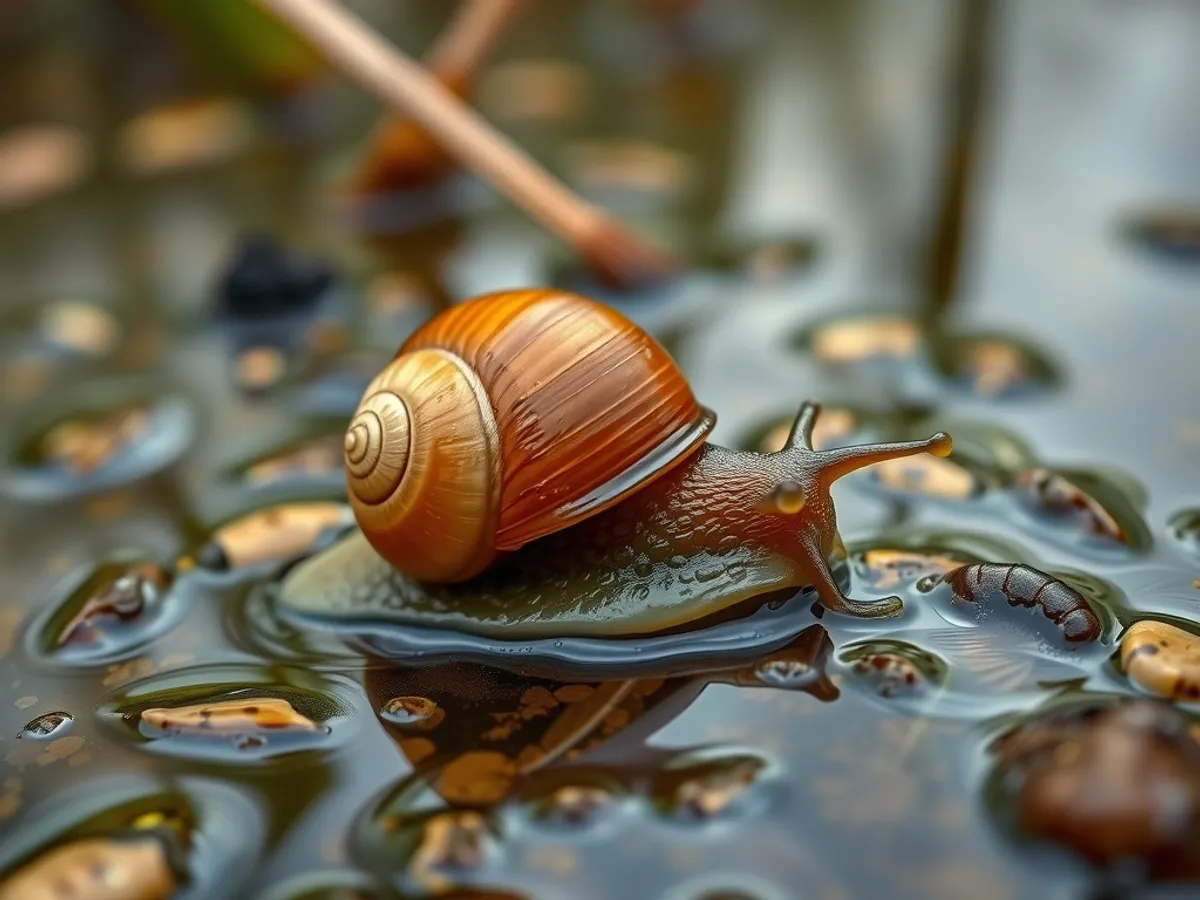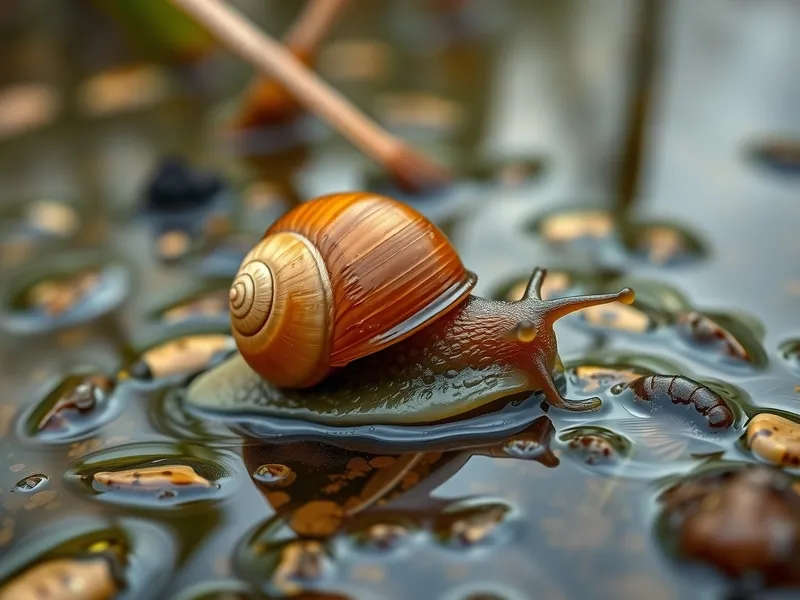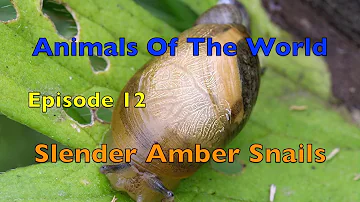
Amber Snail
Succinea putris

Meet the Amber Snail
The Amber Snail is a small terrestrial gastropod mollusk recognized for its translucent, amber-colored shell. It is most commonly found in moist habitats near freshwater sources such as streams, rivers, and marshes. The snail prefers environments with abundant vegetation, where it feeds primarily on decaying plant matter and algae. Amber Snails play a role in nutrient cycling within wetland ecosystems and serve as prey for a variety of birds, amphibians, and insects.
Classification
Invertebrate
Habitat
Wetlands and freshwater margins
Diet
Herbivore
Lifespan
1-2 years
Conservation
Least Concern
Weight
0.1-0.3 grams
📖Fascinating Facts
Translucent Shell
The shell of the Amber Snail is thin and translucent, often showing a warm amber color that helps it blend in with decaying plant matter.
Wetland Dweller
Amber Snails thrive in humid environments and are commonly found along the edges of ponds, marshes, and slow-moving rivers.
Hermaphroditic Reproduction
Like many snails, Amber Snails are hermaphrodites, meaning each individual has both male and female reproductive organs.
📋Detailed Description
The Amber Snail (Succinea putris) is a small, terrestrial pulmonate gastropod mollusk in the family Succineidae, typically measuring 12–17 mm in shell length and 6–8 mm in width. Its shell is thin, fragile, and distinctly translucent with a glossy amber to yellowish-brown hue, allowing internal organs to be faintly visible. The shell is elongated-oval with a relatively large aperture and only a few whorls, making it lightweight and well-suited for movement among dense wetland vegetation. The soft body is pale yellow to orange, with two pairs of tentacles; the upper, longer pair bears the eyes. Succinea putris is primarily nocturnal or crepuscular, emerging during periods of high humidity to avoid desiccation. It is a slow-moving detritivore, feeding on decaying plant material, algae, and biofilm on submerged or emergent vegetation. The species is hermaphroditic, possessing both male and female reproductive organs, and typically mates during the warmer months. Eggs are laid in clusters on moist substrates, with juveniles hatching after 2–4 weeks depending on temperature. Amber Snails are important in wetland ecosystems, contributing to decomposition and nutrient cycling, and serving as prey for a variety of birds, amphibians, and invertebrates.
💡 Did you know?
Amber Snails can breathe both through their skin and a specialized lung, allowing them to survive in fluctuating water conditions.
🔬Research & Sources
Wikipedia Summary
Oxyloma is a genus of air-breathing land snails, terrestrial pulmonate gastropod mollusks in the family Succineidae, the ambersnails.
Last Modified: 12/18/2024
🎭Behavior & Social Structure
Succinea putris is generally solitary but may be found in loose aggregations where food and moisture are abundant. It is most active during the night or after rainfall, when humidity is high, reducing the risk of desiccation. The snail moves slowly across vegetation and detritus, using its muscular foot and secreting mucus to facilitate locomotion. Feeding involves scraping algae, fungi, and decaying plant matter from surfaces with its radula, a specialized rasping tongue. The species exhibits thigmotactic behavior, favoring close contact with moist surfaces and often hiding under leaves or debris during dry periods. There is little evidence of complex social interactions, though individuals may engage in reciprocal mating. When threatened, the snail retracts into its shell, though the thinness of the shell offers limited protection against predators.
👶Reproduction & Life Cycle
Amber Snails are simultaneous hermaphrodites, meaning each individual possesses both male and female reproductive organs. Mating typically occurs from late spring through summer, often triggered by increased temperature and humidity. During copulation, two snails exchange sperm, after which each may lay up to 100 small, gelatinous eggs in clusters on damp vegetation or soil. The eggs hatch after 14–28 days, depending on environmental conditions. Juveniles resemble miniature adults and undergo direct development, with no larval stage. There is no parental care after egg-laying. Sexual maturity is usually reached within 2–3 months, and the lifespan is generally one year, though some individuals may survive longer in favorable conditions.
🛡️Adaptations & Survival
Succinea putris exhibits several adaptations for wetland life. Its thin, lightweight shell reduces energy expenditure and facilitates movement among dense, waterlogged vegetation. The translucent shell may provide some camouflage against predators. The snail's ability to absorb oxygen through its skin and mantle cavity allows survival in humid, low-oxygen environments. Behavioral adaptations include nocturnal activity and estivation during dry periods to minimize water loss. The species' reproductive strategy—hermaphroditism and high fecundity—ensures rapid population recovery after disturbances. Its radula is adapted for scraping a wide variety of food sources, contributing to its ecological versatility.
📚Research Sources
🎨Cultural Significance
Amber Snails have limited direct significance in human culture, but their distinctive, translucent shells have occasionally been collected by naturalists and shell enthusiasts. In some regions, they are used as bioindicators of wetland health due to their sensitivity to environmental changes. There are no known traditional uses or significant roles in folklore or mythology. However, their ecological role in nutrient cycling and as prey for wetland birds has indirect value for biodiversity and ecosystem services.
🔬Recent Research & Discoveries
Recent research on Succinea putris has focused on its role as an intermediate host for parasitic trematodes, such as Leucochloridium paradoxum, which manipulate snail behavior to facilitate transmission to bird hosts. Studies have also examined the snail's response to environmental stressors, including pollutants and habitat modification, highlighting its potential as a bioindicator species. Molecular phylogenetic work has clarified relationships within the Succineidae family, revealing cryptic diversity and aiding in conservation assessments. Ongoing research is investigating the impacts of climate change on wetland gastropod communities and the adaptive mechanisms that allow S. putris to persist in variable environments.
🎥Wildlife Videos

Giant Snail Uses "Snorkel" to Breathe Underwater | How Nature Works | BBC Earth
Floods are slowly suffocating the Pantanal's ecosystem, but luckily, these ingenious water-breathing snails might be able to save ...
BBC Earth

Snails - Fantastic Creatures - Go Wild
When the first rays of sunlight warm the forest, a very special animal awakes. It has been hibernating for the past months, dug into ...
Go Wild

Slow down with Snails and Slugs | Relax With Nature | BBC Earth
Allow yourself to move at a snail's pace and relax with the movement of these slow-moving creatures. Subscribe: ...
BBC Earth

Relax with Snails, Frogs and Animal Families | The Wild Place | BBC Earth
Watching images of nature has been shown to help our mental and physical wellbeing. So, relax as you slow down with snails, ...
BBC Earth

Slender Amber Snails: Animals of the World Episode 12
moo.
Briar Nordström

NY Upstate Outdoors: Saving the endangered Chittenango Ovate Amber Snail
Senior Research Support Specialist for the SUNY ESF Research Foundation Cody Gilbertson works to save the Chittenango ...
NYup
🌍Habitat Information
The Amber Snail typically inhabits Wetlands and freshwater margins environments. Amber Snails have adapted to their environments with specialized features and behaviors.
Primary Habitat:
Wetlands and freshwater margins
More detailed habitat information will be available soon.
🛡️Conservation Status
The Amber Snail is currently classified as Least Concern. Conservation efforts are crucial for preserving this species for future generations.
Common Threats:
- 🏠Habitat loss and fragmentation
- 🌡️Climate change impacts
- 🎯Hunting and poaching
- 🏭Human-wildlife conflict
⚠️Threats & Conservation Challenges
While Succinea putris is currently classified as Least Concern by the IUCN, it faces localized threats from habitat loss due to wetland drainage, pollution, and agricultural expansion. Pesticide runoff and eutrophication can degrade habitat quality and reduce food availability. Climate change poses additional risks by altering hydrological regimes and increasing the frequency of droughts. The species is sensitive to desiccation and cannot survive prolonged dry conditions. Invasive species, such as predatory flatworms, may also impact populations in some regions. Despite these challenges, the species remains widespread and adaptable in much of its range.
🔬Scientific Classification
Scientific Name
Succinea putris
Classification Hierarchy
🔍 About Taxonomic Classification
Taxonomic classification is a hierarchical system used by scientists to classify and organize living organisms based on shared characteristics and evolutionary relationships.
The system moves from broad categories (Kingdom) to increasingly specific ones, with each animal's scientific name typically consisting of its Genus and species.
📝Community Notes
Share your observations and insights about the Amber Snail with our community of wildlife enthusiasts.
Join Our Community
Sign in to share your observations and connect with fellow wildlife enthusiasts.
Sign In to ContributeNo community notes yet
Be the first to share your observations about the Amber Snail!
Explore Amber Snail
Select a tab above to learn more about this amazing animal.
📸Photo Gallery
No photos available for this animal yet.
🌟Discover More Wildlife
Continue your journey of discovery with more fascinating animals from our database
